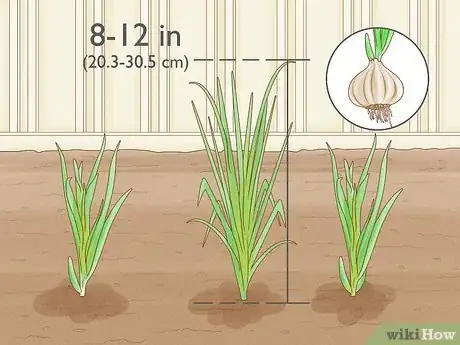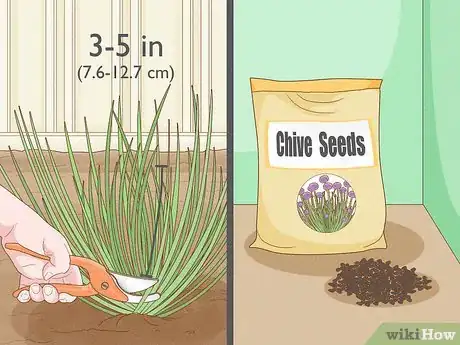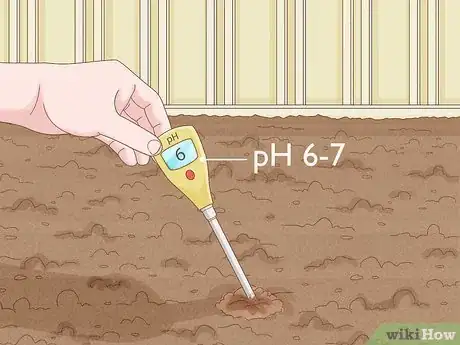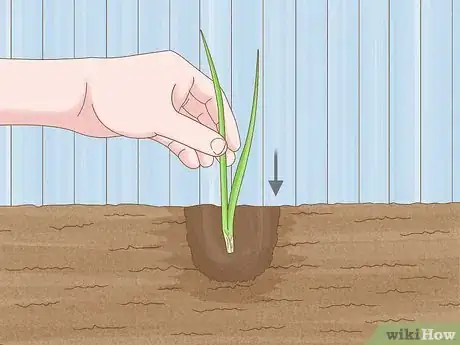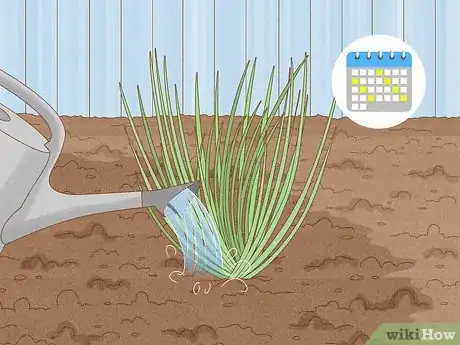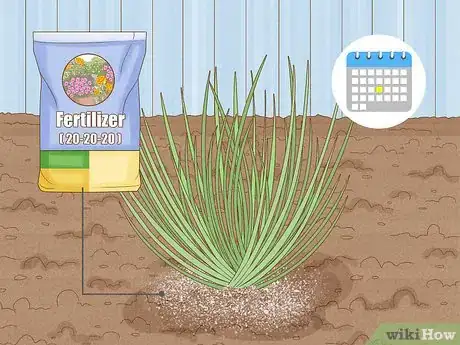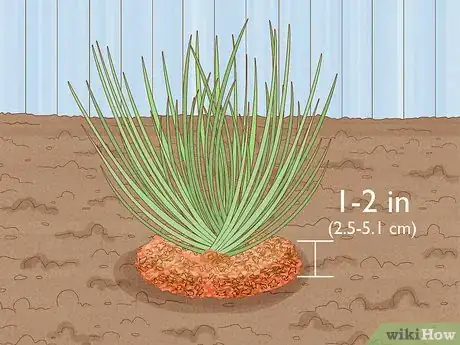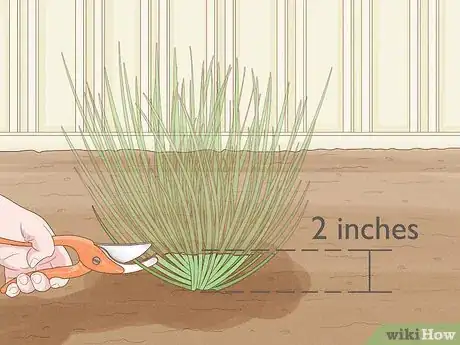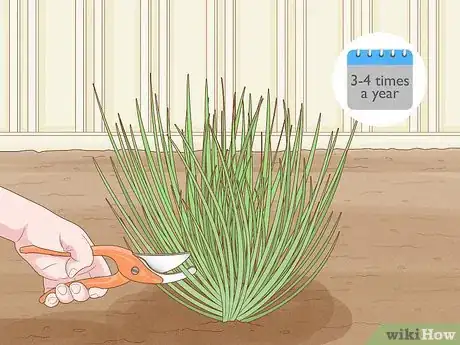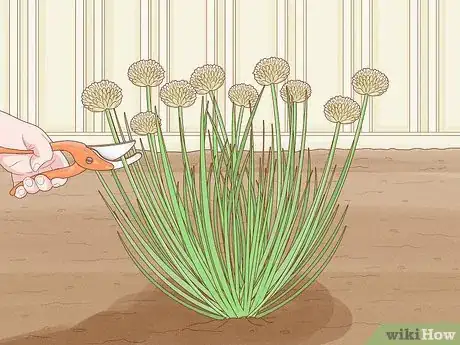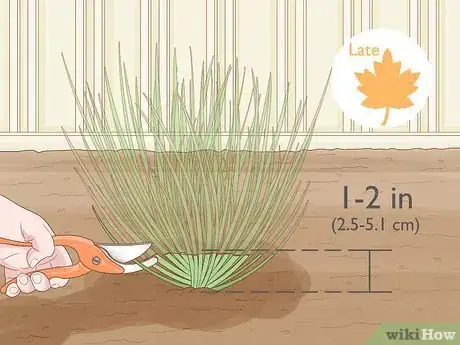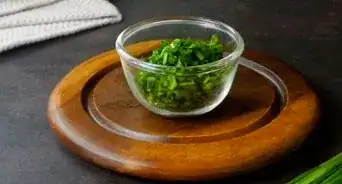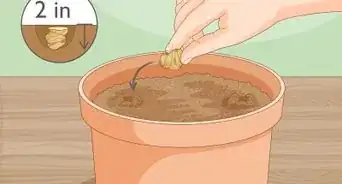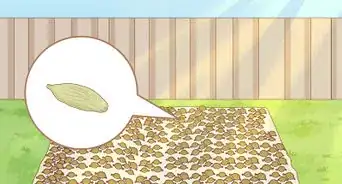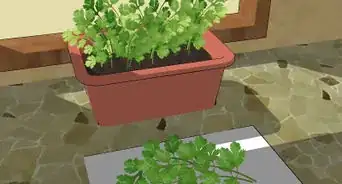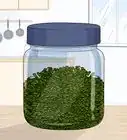This article was co-authored by Andrew Carberry, MPH. Andrew Carberry is a Food Systems Expert and the Senior Program Associate at the Wallace Centere at Winrock International in Little Rock, Arkansas. He has worked in food systems since 2008 and has experience working on farm-to-school projects, food safety programs, and working with local and state coalitions in Arkansas. He is a graduate of the College of William and Mary and holds a Masters degree in public health and nutrition from the University of Tennessee.
There are 8 references cited in this article, which can be found at the bottom of the page.
This article has been viewed 131,181 times.
Chives are a member of the onion family, but unlike most onions, the greens are harvested instead of the bulb. In comparison to standard onions, chives have a much milder taste. The small grass-like herb is often added to soups, salads, and sauces for it's light flavor and aesthetic appeal. Whether you're using chives for cooking or as an ornamental addition to your garden, the entire process from choosing a species of chive, preparing your garden, planting, and harvesting is quite easy. Chives can grow in a variety of climates, including USDA hardiness zones 3 through 10.[1]
Steps
Choosing a Type of Chives
-
1Consider growing onion chives for cooking. Onion chives, also called common chives, are the most popular variety of the plant. Onion chives are slightly onion flavored and scented (as the name suggests), and are used in salads and as toppings for many cooking dishes for a subtle flavor enhancement. These chives grow anywhere from 8–12 inches (20.3–30.5 cm) in length, and are bright to dark green in color. They have the traditional tube-shaped stem which is hollow at the center.
-
2Look into growing garlic chives for cooking. Sometimes called ‘Chinese chives’, garlic chives are another type of chives used in cooking. These chives smell like violets when the stem is crushed, but taste reminiscent of garlic. As a result, they are used in dishes to bring out the garlic flavor. Unlike onion chives, garlic chives have flat stems, and the flower buds can be used in cooking as well (typically in stir-frys). Garlic chives are bright to dark green in hue, and grow to be 12–18 inches (30.5–45.7 cm) in height.Advertisement
-
3Consider growing giant Siberian chives. Although the name sounds quite grand, giant Siberian chives are actually just a slightly larger variety of onion chives. These chives have the strongest flavor, but are typically used in gardens for their size (20-30 inches in height) around the borders of a plot. Giant Siberian chives are blue-green in color, and are tubular in shape. They have an onion-esq flavor and scent when added to cooking dishes.[2]
-
4Consider growing chives for their flowers. Although many people only think of chives as the baked potato topping, chives are actually a type of lily which produce lovely purple blooms. The flowers are about the size of a quarter and feature many rows of small, thin petals similar to a dandelion. The flowers of the chive plant entice beneficial insects to your garden, which in turn kill off the pests and unwanted bugs that might be around. Additionally, chive flowers are edible, making them a great addition to your cooking.
- Cut off the flowers before they have completely opened, and add them to salads or use them as decoration on baked goods.
- All varieties of chives grow flowers.
Preparing to Plant
-
1Choose a growing method. There are two ways to grow chives: from a preexisting plant/cutting, or from seeds. Most gardeners recommend growing your chives from a bulb or from a start from another chive plant, because growing chives from seeds takes two full years. If you choose to grow from a preexisting plant (available at nurseries), select a start that is bright green, full, and is at least 3–5 inches (7.6–12.7 cm) in height. These are indicators of a healthy chive plant, and increase the likelihood of it flourishing in your garden.[3]
- Growing from seeds involves starting seeds indoors a few months prior to planting them outdoors, and transplanting in the springtime. The seeds will grow into plants, but they cannot be harvested for 2 years.
- Chive plants grow in bulbs that are divided every 3-4 years, so you can plant a divided bulb from a friend or neighbor’s chive plot, that will grow into an entirely new plant.
- Planting seeds, bulbs, and starts outdoors is the same process. Seeds are the only growing method that take a bit extra work prior to outdoor planting.
-
2Select a garden plot in full sun. Chives are sun-loving plants, and although they will still grow in shade, they will produce the biggest harvest when placed in full sun. Find a plot in your garden that has sunlight most of the day.
- If your garden is shaded, choose a patch that gets at least 4-6 hours of sunlight to satisfy the chives’ sun needs. Chives planted in partial sun will grow slowly, so expect smaller or less frequent harvests.
-
3Prepare your garden soil. Although some plants can grow in dense, hard soils, chives need light, loamy, and sandy soils with good drainage. If you’re working with soil that has a lot of clay or is very dense, mix in some sand to loosen it up. Additionally, add in a garden-quality compost mixture to mix nutrients into the soil. If possible, amend the soil 4-6 weeks prior to planting, so that the soil can have time to adjust to the changes.
-
4Balance the pH of the soil before planting. Chives need soil with a pH between 6 and 7.[4] Test the soil, and if it is too low, increase the pH by chopping agricultural lime into the soil using a garden trowel or small shovel. If it is too high, lower the pH by mixing in a fertilizer with urea phosphate or ammonium nitrate, or by adding compost, manure, or plant litter.
- Test the pH using cabbage for an easy DIY method.
- You can test soil pH by using a store-bought test probe for exact measurements.
-
5Know when to plant. Chives are summer-blooming plants that should be planted in the early spring. If you are starting your chives as seeds, start them indoors 8-10 weeks prior to your outdoor planting date. Planting outdoors should occur 1-2 weeks after the last frost of the winter, typically around March or April (depending on your growing zone).
Planting Your Chives
-
1Water the soil to prevent transplant shock. Prior to planting your chives, wet the soil with a hose so that it is damp. This will help to prevent transplant shock of the new chive plants in your garden. Make sure that the soil is not muddy, just moist enough to form clumps when squeezed in your hand.
- Transplant shock is a plant’s reaction to being dug up/relocated to a new environment, and is totally normal. It can cause problems if the plant is not cared for post-transplant, though.
- Your plant might have transplant shock if it is wilted-looking and generally sickly in appearance.
-
2Dig a hole 2–4 inches (5.1–10.2 cm) deep. Chives grow from small bulbs at the base, which need to be covered fully when planted. The bulbs aren’t typically that large, so a hole no bigger than 2–4 inches (5.1–10.2 cm) deep and equally wide should be necessary.
-
3Plant the chives. Place each chive plant into the hole, and replace soil over the top. Make sure that the chives are planted at the same depth they were in the pots. If the soil buries part of the stem that was previously exposed to air, the plant could rot.
-
4Water the chives every few days. The soil should be moist when you water your chives, so you need not water them again immediately after. Chives don’t require a lot of moisture, so add water only when the soil is completely dry. The frequency of waterings will depend on the weather in your area, but may vary from once every 1-3 days.
-
5Apply a fertilizer once a month. Your chive harvest will prosper with a bit of fertilizer applied once every 3-4 weeks. Choose a 20-20-20 mixture (equal parts nitrogen, phosphorous, and potassium), and incorporate it into the soil according to package directions.
-
6Add a layer of mulch to prevent weeds. If you’re concerned about weeds in your garden, adding a layer of mulch will help block them out. Pull all weeds around the chives first, then apply a layer of mulch to prevent new weed growth. Mulch is often sold in the form of compost or bark at garden supply stores, but can be any organic material used as a surface treatment for soil. Add a layer 1–2 inches (2.5–5.1 cm) thick over the top of the soil, to block out weeds and to trap moisture for longer.
-
7Keep an eye out for pests and disease. Few pests are interested in chives, but onion pests, like the onion fly, may gravitate toward your chives if you have true onions planted nearby. A few fungal diseases, like rust, may also attack chives on a rare basis. A small amount of pesticide or fungicide can usually restore your chives if these problems do occur.[5]
Harvesting Your Chives
-
1Wait to harvest your chives when they are at least 7 to 10 inches (17.8 to 25.4 cm) in height. The overall size of your chives will vary depending on the variety you grow, but all varieties are harvestable around 7–10 inches (17.8–25.4 cm). This normally occurs around mid summer, and will continue until the weather cools below freezing. In some areas with light winters, chives will remain evergreen and produce harvestable plants until the following year.
-
2Cut chives 2-inches from the base. Use a pair of gardening shears or scissors to cut your chives straight across, starting from the outside of the plant and working in. Cut the chives about 2-inches from the base of the plant, as this will stimulate new growth for additional harvests. Do not harvest the entire plant at one time; cutting all of the leaves off will stop future growth. Try not to cut them at an angle, as this will cause them to lose moisture more rapidly than if they are cut straight across. This is because cutting at an angle exposes more of the stem, and therefore moisture in the plant dissipates more quickly.
-
3Harvest your chives 3-4 times per year. For the best-tasting crop, harvest your chives during the summer and late fall 3 to 4 times total during the year. It is not necessary to harvest the entire plant at once; only cut what you need from a patch, and harvest that particular patch 3-4 times per year.
-
4Deadhead the flowers when they start to seed. Chives can become an invasive species, as they are self-seeding and pollinating and may take over your garden. To prevent this, cut off the flower heads at harvesting time. This will prevent the flowers from seeding and spreading to other areas of your garden. Continue deadheading the flowers at each harvest.[6]
-
5Cut off all the chives at the end of the growing season. As a form of pruning, cutting off all the chives in the late fall will help to produce a better crop the following summer. Use your gardening shears to cut off the top of the entire chive plant 1–2 inches (2.5–5.1 cm) from the base. This should be done around the months of October or November. Chives are perennial plants, so they will continue to grow back on their own so long as they are taken care of.
-
6Divide chive plants every 3 to 4 years. As a result of continually growing for many years, chives can get quite large. To prevent the chives from overtaking your garden and becoming unruly, it is practice to divide the chive plants every few years. Chives are a type of bulb, so they are easy to divide. Simply dig down in the dirt to reach the bulb, and split each large plant into sections ⅓ the original size for replanting.[7] Give the extra sections to friends and neighbors to start their own herb garden, or add them to your compost.
- Consider replanting chive your spare chives at the base of your apple trees. The chive plants will prevent a type of disease called ‘apple scab’ from occurring on the trees.
- Chives are said to repel deer, so consider planting your spare divisions in an area that deer have been a problem for you.[8]
Expert Q&A
Did you know you can get premium answers for this article?
Unlock premium answers by supporting wikiHow
-
QuestionHow do I grow chives from seeds?
 Andrew Carberry, MPHAndrew Carberry is a Food Systems Expert and the Senior Program Associate at the Wallace Centere at Winrock International in Little Rock, Arkansas. He has worked in food systems since 2008 and has experience working on farm-to-school projects, food safety programs, and working with local and state coalitions in Arkansas. He is a graduate of the College of William and Mary and holds a Masters degree in public health and nutrition from the University of Tennessee.
Andrew Carberry, MPHAndrew Carberry is a Food Systems Expert and the Senior Program Associate at the Wallace Centere at Winrock International in Little Rock, Arkansas. He has worked in food systems since 2008 and has experience working on farm-to-school projects, food safety programs, and working with local and state coalitions in Arkansas. He is a graduate of the College of William and Mary and holds a Masters degree in public health and nutrition from the University of Tennessee.
Food Systems Expert
-
QuestionHow long can I grow chives for?
 wikiHow Staff EditorThis answer was written by one of our trained team of researchers who validated it for accuracy and comprehensiveness.
wikiHow Staff EditorThis answer was written by one of our trained team of researchers who validated it for accuracy and comprehensiveness.
Staff Answer wikiHow Staff EditorStaff Answer
wikiHow Staff EditorStaff Answer -
QuestionHigh high do chives grow?
 wikiHow Staff EditorThis answer was written by one of our trained team of researchers who validated it for accuracy and comprehensiveness.
wikiHow Staff EditorThis answer was written by one of our trained team of researchers who validated it for accuracy and comprehensiveness.
Staff Answer wikiHow Staff EditorStaff Answer
wikiHow Staff EditorStaff Answer
Things You’ll Need
- Potted chives
- Fertilizer
- pH tester
- Trowel or small shovel
- Hose or watering can
- Chive seeds
- Scissors
- Pesticide and fungicide, only as needed
References
- ↑ http://www.almanac.com/plant/chives
- ↑ http://homeguides.sfgate.com/varieties-chives-24616.html
- ↑ http://bonnieplants.com/growing/growing-chives/
- ↑ http://www.southernliving.com/home-garden/gardens/chives-00400000006797/
- ↑ http://www.gardeningblog.net/how-to-grow/chives/
- ↑ http://www.southernliving.com/home-garden/gardens/chives
- ↑ http://herbgardening.com/growingchives.htm
- ↑ http://www.motherearthliving.com/gardening/the-great-chive-division.aspx#axzz333fBzjCU
About This Article
To grow chives, start by tilling the soil in your garden, and add extra compost if you have clay-based soil. Be sure to water the soil before planting your chives to ensure that the dirt is damp enough for roots to form. Then, dig a hole 2 to 4 inches deep and place the chive in the hole, covering the bulb completely with soil. Remember to water your chives every 1-3 days to keep the soil moist, and apply fertilizer once per month. Once the chives reach 7 inches tall, you can harvest them by cutting them 2 inches from the base. For more advice from our Gardener reviewer, including how to divide your chives to keep them from getting too large and even taking over your garden, read on!

